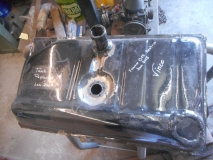I think some one got bitten by the Long Haul League, the Iron Buggy Award and all the recent cross country traveling.
Bud sent me his fuel tank and a pile of photos, and I agreed to modify his fuel tank for a larger volume and to get almost 100% usage of the capacity out of it.


Since it is always best to work on a clean slate, I sand blasted the fuel tank to white metal. Not only does it expose any rust, (this tank had no external rust), it also allows for good welding surfaces.


Several minute modifications were made to get all the fuel that can be gotten.
One modification is to change how the filler neck is mounted. If the filler neck extends into the tank, the air trapped above the bottom of the neck is wasted fuel storage space. Since Bud's buggy has been restored last year, it was very important to keep the filler neck in the exact same spot that will re-match in the hood opening. To do this, several precise measurements were needed to re-locate it after the modification. I set up a jig on a buggy so it could be taken off after the initial measurement was taken, then replaced in the exact same spot to aid in the filler neck location.





Once the neck position and angle was established, the neck was cut out.

A flat plate of 14 gauges steel was then welded over the hole in the tank. The locating jig was replaced, and the cleaned up neck measured for how much needed to be trimmed off to surface mount it.

The neck was shortened the proper amount, located, outlined, and then the hole cut before welding the neck on. Also, Bud stated that sometimes he would get a fuel smell inside to cabin of the buggy. So I installed a vent port into the neck. The port is brake line tubing sanded to bare metal, the neck sanded to bare metal, then the two bonded with Silver Solder. (True high content Silver based solder, not plumbing solder. Silver solder is a lot stronger than brazing) Then a small barb was crimped into the end to help hold a hose on.
Then the neck was welded in place while using the locating jig for exact placement.



This takes care of the top of the tank modifications and gets that last little bit of fuel leaving almost zero head space wasted. Next is the bottom.




























